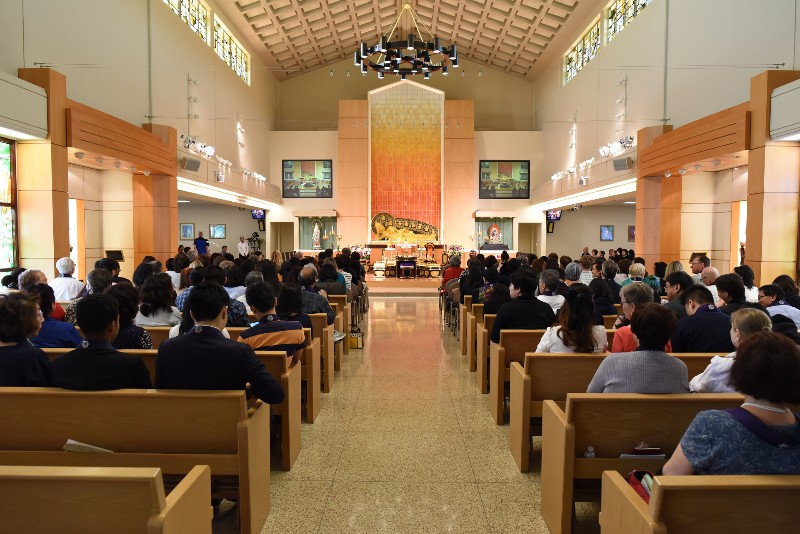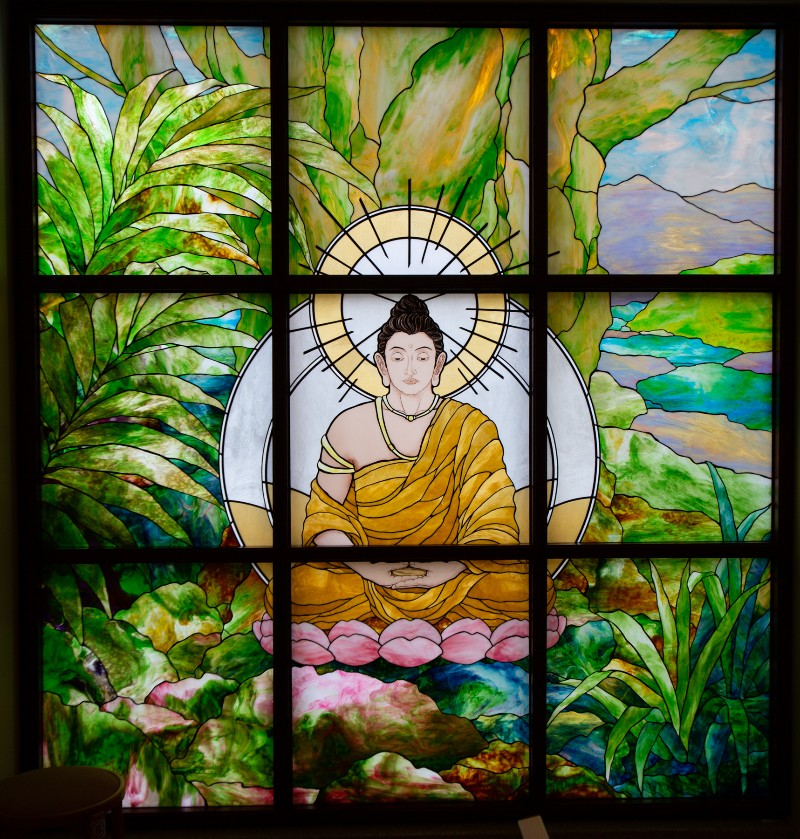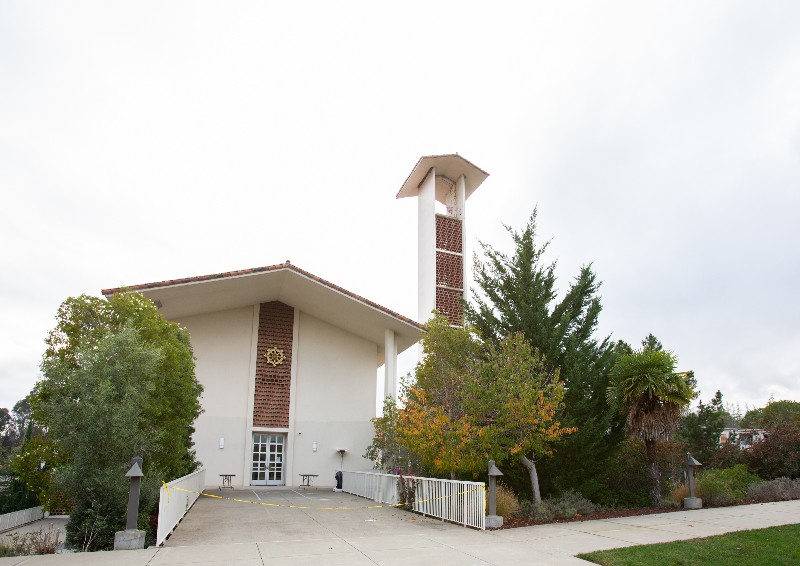By Aimee Lewis Strain
The Japanese word “shinnyo-en” is defined as a garden open to all, where everyone can discover and bring out their true nature. That description precisely fits a 26-acre spot in Redwood City that is occupied by the U.S. headquarters of an international Buddhist community by that name.
Shinnyo-en USA Head Temple sits on a majestic piece of open space on Bret Harte Drive. Its existence isn’t well known even by neighbors, despite the temple’s significance to its practitioners and the welcoming attitude they have when visitors wander onto the grounds.
“Many people don’t know that we’re here,” said Facilities Manager Mark O’Malley. “We bought this property in 2004 and we had our dedication in 2008, but many people don’t know that we’re an actual functioning Buddhist temple.”
Bret Harte Drive ends at the white gates of this beautiful property covered in trees and relatively untouched by development except for the 100,000-square-foot temple. The gates are open for residents to walk through each day; many are on their way to Roy Cloud School or just taking a stroll.
O’Malley says the public is welcome during daylight hours to walk the loop road through the property, but should be cautious since the road is shared with traffic.
The Redwood City Parks and Arts Foundation twice has held its Picnic en Blanc fundraiser on the grounds of the temple. The location of the picnic is always kept secret until the day before the event, adding to the surprise of attendees who previously hadn’t known that a Buddhist temple even existed in Redwood City.
Former Home to Nuns
The property was purchased from the Sisters of the St. Francis of Assisi, who had the building constructed in 1958 positioned on a hill overlooking the Bay Area. The congregation of Catholic sisters used the building as a place for worship and also as their living quarters, much like a convent, according to the Reverend Shunichi Ikehari, of Shinnyo-en. At one point about 100 nuns lived on the property. They would open their doors to various groups, including those seeking to complete religious retreats, he said.
As the sisters aged and became less capable of maintaining the property, they chose to sell the parcel. They interviewed many of the potential buyers but settled on the Shinnyo-en Temple because of its mission and intentions for using the site.

“The sisters prayed inside this temple day and night and when we purchased the site, we took over their wishes to worship,” Ikehara said. “We made a promise to preserve what the sisters of St. Francis of Assisi had built.”
The connection between the Buddhist temple and the St. Francis sisters is one of mutual friendship between religious traditions. Still, nearly two decades after the sale of the property, many items inside from the Catholic days remain, a legacy to the sisters who built it, according to O’Malley.
Honoring the Sisters
The temple’s architecture is in a cruciform shape, with pews in all directions. The Shinnyo-en Temple adherents chose to keep the pews out of respect for the sisters. The sisters also gifted the temple with a statue of St. Francis, which still today sits in the main altar room.
“The sisters gave us their statue and we sent it to Japan so that we could replicate the statue and create one of the 7th Century Prince Shotoku,” the Reverend Leopold Fan said. Both statues sit across from one another, a symbol of unity between the sisters and the Buddhists.
There are four 12-foot stained-glass panels that the Shinnyo-en Temple replaced with their own, features not traditionally seen in a Buddhist temple, O’Malley said. An artist in Japan created the stained-glass panels—four in all—which depict the various stages of Buddha’s life.

On the altar there are three buddhas, one standing, one sitting and one lying down, to represent his last teaching.
The large building holds a meditation room, an auditorium, many classrooms, cafeterias and an industrial kitchen. There are also dormitories on the property, but at this point they are not being used by the temple, as they are not up to code.
Shinnyo-en is an international Buddhist community founded on the ancient wisdom and compassion taken from the teachings of Buddha Shakyamuni. Shinnyo-en is a lay Buddhist order that is based on the Nirvana (Mahaparinirvana) Sutra, according to Ikehara. Considered the final teaching of Buddha, this set emphasizes that all people have the capacity to find their true selves and that acting with compassion and concern for others, this authentic self will be found.
The Way to Happiness
Shinnyo Buddhism teaches that finding happiness is dependent on the way individuals interact with the people and the world around them. The term “shinnyo” combines spiritual awakening and the nature of reality. The “en” refers to open space or a boundless garden. Put together, “shinnyo-en” becomes a place for people to come together and bring out their inner buddha or awakened nature, according to Fan.
“We believe in three endeavors—community service, donation and sharing Dharma,” Fan said. “We place great importance on what we can do to make the world better.”
Shinnyo-en USA’s first temple on the mainland was in 1982 in a small house on Jefferson Street in San Francisco’s Marina district, a home the order still owns. Once the temple outgrew the house, the Buddhist practitioners moved into what is now Hoover School in Burlingame, until they outgrew that site as well, O’Malley said.
Today, Shinnyo-en USA boasts nearly 500 members who come from different counties including San Francisco, San Mateo and Santa Clara. There are weekend services, meditation sessions, and many planned pride-and-beautification activities. Canned food and toy drives and community service projects are scheduled for members to work together to improve the surrounding community, according to Fan. A youth association has nearly 100 members.
As is true with many churches and other religious organizations, the Covid pandemic had a negative impact on the number of members in the order, but online services have helped, O’Malley said. During the pandemic, many services were held outside and a gravel area was tented so services could be held. Many rituals are broadcast from Japan. Services are translated into English, Japanese, Cantonese, Mandarin Korean.
For more information, visit the website at shinnyoenusa.net.






